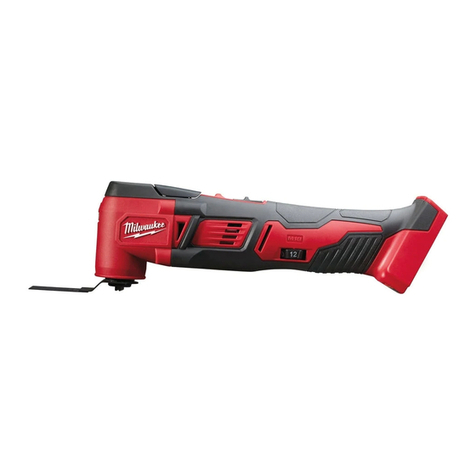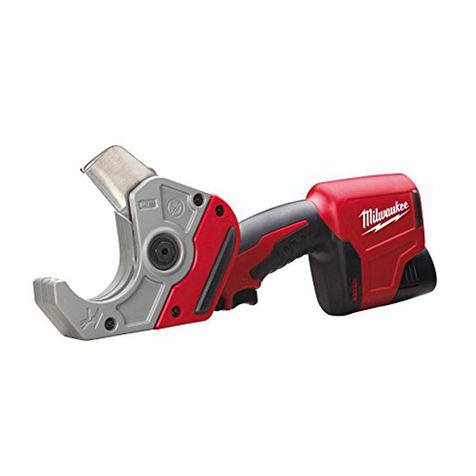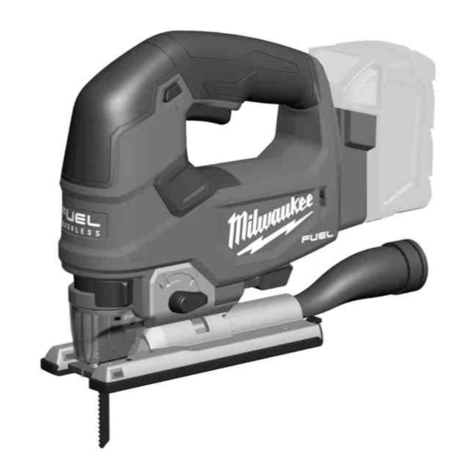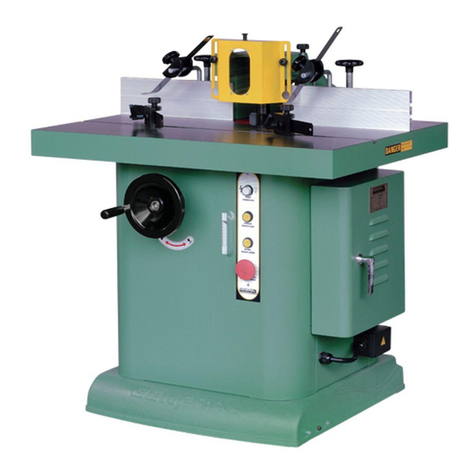
23
PERSONAL SAFETY
GENERAL POWER TOOL SAFETY WARNINGS
WORK AREA SAFETY
ELECTRICAL SAFETY
WARNING READ ALL SAFETY WARNINGS AND ALL INSTRUCTIONS. Failure
to follow the warnings and instructions may result in electric shock, fire and/or serious
injury. Save all warnings and instructions for future reference. The term "power
tool" in the warnings refers to your mains-operated (corded) power tool or battery-operated
(cordless) power tool.
POWER TOOL USE AND CARE
SERVICE
SPECIFIC SAFETY RULES
•Keep work area clean and well lit. Cluttered or
dark areas invite accidents.
•Do not operate power tools in explosive at-
mospheres, such as in the presence of flam-
mable liquids, gases or dust. Powertoolscreate
sparks which may ignite the dust or fumes.
•Keep children and bystanders away while
operating a power tool. Distractions can cause
you to lose control.
•Power tool plugs must match the outlet. Never
modify the plug in any way. Do not use any
adapter plugs with earthed (grounded) power
tools. Unmodified plugs and matching outlets will
reduce risk of electric shock.
•Avoid body contact with earthed or grounded
surfaces such as pipes, radiators, ranges and
refrigerators. Thereisanincreasedrisk of electric
shock if your body is earthed or grounded.
•Do not expose power tools to rain or wet con-
ditions. Water entering a power tool will increase
the risk of electric shock.
•Do not abuse the cord. Never use the cord for
carrying, pulling or unplugging the power tool.
Keep cord away from heat, oil, sharp edges
or moving parts. Damaged or entangled cords
increase the risk of electric shock.
•When operating a power tool outdoors, use an
extension cord suitable for outdoor use. Use
of a cord suitable for outdoor use reduces the risk
of electric shock.
•If operating a power tool in a damp location
is unavoidable, use a residual current device
(RCD) protected supply. Use of anRCD reduces
the risk of electric shock.
attached to a rotating part of the power tool may
result in personal injury.
•Do not overreach. Keep proper footing and
balance at all times. This enables better control
of the power tool in unexpected situations.
•Dress properly. Do not wear loose clothing or
jewellery. Keep your hair, clothing and gloves
away from moving parts. Loose clothes, jewel-
lery or long hair can be caught in moving parts.
•If devices are provided for the connection of
dust extraction and collection facilities, ensure
these are connected and properly used. Use of
dust collection can reduce dust-related hazards.
•Do not force the power tool. Use the correct
power tool for your application. The correct
power tool will do the job better and safer at the
rate for which it was designed.
•Do not use thepowertooliftheswitchdoesnot
turn it on and off. Any power tool that cannot be
controlled with the switch is dangerous and must
be repaired.
•Disconnect the plug from the power source
and/or the battery pack from the power tool
before making any adjustments, changing
accessories, or storing power tools. Such
preventive safety measures reduce the risk of
starting the power tool accidentally.
•Store idle power tools out of the reach of chil-
dren and do not allow persons unfamiliar with
the power tool or these instructions to operate
the power tool. Powertools are dangerous inthe
hands of untrained users.
•Maintain power tools. Check for misalignment
or binding of moving parts, breakage of parts
and any other condition that may affect the
power tool’s operation. If damaged, have the
power tool repaired before use. Manyaccidents
are caused by poorly maintained power tools.
•Keep cutting tools sharp and clean. Properly
maintained cutting tools with sharp cutting edges
are less likely to bind and are easier to control.
•Use the power tool, accessories and tool bits
etc., in accordance with these instructions,
takingintoaccounttheworkingconditionsand
the work to be performed. Use of the power tool
for operations different from those intended could
result in a hazardous situation.
•Stay alert, watch what you are doing and use
common sensewhen operatinga powertool. Do
not usea power toolwhile youare tiredor under
theinfluenceof drugs, alcohol or medication. A
moment of inattention while operating power tools
may result in serious personal injury.
•Use personal protective equipment. Always
wear eye protection. Protective equipment such
as dust mask, non-skid safety shoes, hard hat, or
hearingprotection used for appropriate conditions
will reduce personal injuries.
•Prevent unintentional starting. Ensure the
switch is in the off-position before connecting
to power source and/or battery pack, picking
up or carrying the tool. Carryingpowertoolswith
yourfingeron the switch or energisingpowertools
that have the switch on invites accidents.
•Remove any adjusting key or wrench before
turning the power tool on. Awrench or a key left
•Have your power tool serviced by a qualified
repair person using only identical replacement
parts. Thiswill ensure that thesafetyof the power
tool is maintained.
•Hold tools byinsulatedgrippingsurfaces when
performing an operation where the cutting tool
may contact hidden wiring or its own cord.
Contactwith a “live” wire will make exposedmetal
parts of the tool “live” and shock the operator.
•Maintain labels and nameplates. These carry
important information. If unreadable or missing,
contact a MILWAUKEE service facility for a free
replacement.
•WARNING: Somedustcreatedbypowersanding,
sawing, grinding, drilling, and other construction
activities contains chemicals known to cause
cancer, birth defects or other reproductive harm.
Double Insulated
Volts
Alternating Current/
Direct Current
Amps
SPM Strokes per Minute
Underwriters Laboratories, Inc.,
United States and Canada
1. Motor housing
2. Power cord
3. Toggle switch (not shown)
4. Guard
5. Locking nut
6. Blade positioning screw
7. Lower blade clamping screw (not shown)
8. Lower blade
9. Upper blade
10.Yoke
11.Gear case
FUNCTIONAL DESCRIPTION
3
5
4
7
1
2
11
10
9
86
SYMBOLOGY
SPECIFICATIONS
Capacity Minimum Radius
Cat. No. Steel Stainless Volts
AC/DC RPM Left Right
6805 1.5 mm (16 GA) 1.2 mm (18 GA) 120 4000 1/2" 1"
6815 1.9 mm (14 GA) 1.5 mm (16 GA) 120 4000 3/4" 1"
Some examples of these chemicals are:
•lead from lead-based paint
•crystalline silica from bricks and cement andother
masonry products, and
•arsenic and chromium from chemically-treated
lumber.
Your risk from these exposures varies, depending
on how often you do this type of work. To reduce
your exposure to these chemicals: work in a well
ventilated area, and work with approved safety
equipment, such as those dust masks that are
speciallydesigned tofilterout microscopicparticles.













































